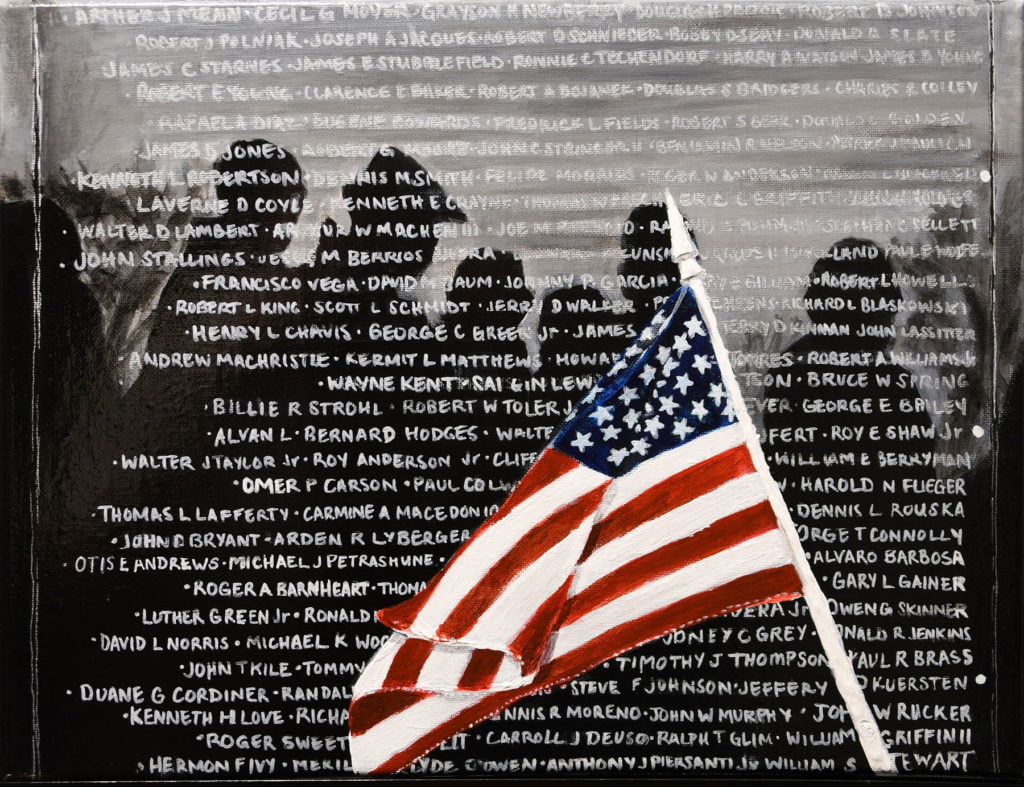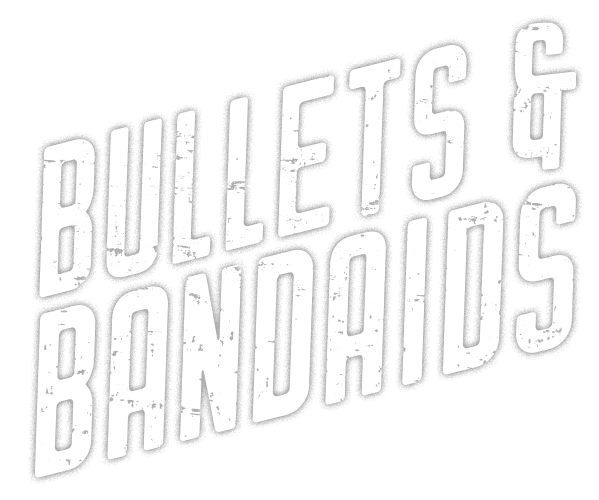
Caylin Paige Stansberry
12” x 16” • Acrylic paint, markers, and Varnish on Canvas
Thank you, Craig Burnette for sharing your story with me. Thank you, Bullets and Band-Aids for creating such a wonderful network and project. For my painting I chose the Vietnam Memorial from Craig’s story. My Medium was acrylic paint, markers, and varnish. My objective was to focus in on the walls reflectiveness, the grief and complexity that the wall represents. I would like to note that I have never seen this monument in person. I have only seen it in pictures and through Craig’s story. I chose to keep the background in black, gray, white and metallic colors to express grief, time past, and keep true to the wall’s actual color. I chose to include the flag in the foreground in color to express honor and valor. I learned through Craig’s story that the names were not in alphabetical order, but in order of casualty. This made his role at the memorial, in 1982, very important to assist the grieving families. I used a black and white reference photo from the event in 1982, as well as the Vietnam Veterans Memorial Fund website to find the names of that spot. It posed a challenge to include the names as legibly as possible, but it was important for me to try. Thank you, again Craig for your story and your service to our country. It was so moving to read your story. I am honored to have participated in this project for Bullets and Band-Aids
Inspired by the experiences of Craig Burnette
Navigating the Wall
by Kristine Hartvigsen
“I visited the wall and found a classroom friend, Ronald Knosky, who was killed in 1967. He was a sweet, funny guy, also known as Goosey. It brought tears to my eyes as I remember his wake and funeral. He was only 21. I touched his name and wished him peace.”
– Nancy C., New Jersey
As a longtime Vet Center therapist, Craig Burnette was more than happy, when duty called in 1982, to provide support to veterans on site in Washington, D.C. where the Vietnam Memorial was being dedicated. A Vietnam vet himself, Burnette had served as an 82nd Airborne Division platoon leader in 1969 working to keep the Viet Minh away from Saigon in a place famously known as the “Iron Triangle.”
“I was selected along with, I think, 20 more of us from Vet Centers around the nation to come in that entire week (of the dedication),” Burnette said. “I was to be available to any Vietnam veteran and others who would come for the big parade and dedication of the wall. We were there as crisis counselors.”
Upon arrival in the Capitol, the counselors went immediately to work, rotating duty at the memorial wall and meeting veterans where they were. “There was hardly any sleep going on. I was so excited,” he said.
At the time, in 1982, there had been no nighttime landscape lighting around the new memorial, and it did not have concrete pathways either, so the ground around it got quite muddy during recent cold rains.
“People don’t realize that the wall, the way it’s designed, the names are not in alphabetical order. They appear based on the date of the casualty,” Burnette recalled. “The first casualty of the Vietnam War is the first name on the upper east wall, and the bottom line on the west wall has the name of the last casualty of Vietnam. So you had to consult a book of names. You had to look it up to find the location. The book gives you the panel number and how many lines down it is. For example, if they looked up one of my buddies, Robert McMillan, the book would tell you which wall and which panel. So if you go to the wall and look up the name Robert McMillan, he’s on panel 15, east, line 21. People were putting pieces of paper over the etchings and made rubbings of the names. Some people were coming in at night, and we had flashlights to read names off the book and scan the wall in the dark with our flashlights to find names on the wall.”
One day Burnette was at the wall during the daytime hours and noticed a couple who seemed confused about the layout, and they didn’t have the book of names. He walked up to them and asked if he could help them find a name. He soon learned that they were a family of Cuban refugees who came to the United States when Fidel Castro took power. They had settled in Grand Rapids, Michigan, where their son attended school. When he turned 19, he wanted to give back and joined the Airborne Rangers. He was killed during combat operations in the Central Highlands of Vietnam. The dates they conveyed coincided with Burnett’s own time in that area of Vietnam.
Burnette assisted the couple in finding their son’s name on the wall, and together they made an etching of it.
“I told them that I knew the area where their son was in terms of the operation he was with. I think it was Charlie Company or the75th Ranger Battalion,” Burnette said. “I knew the area they were working. I wasn’t working with them directly, but I knew who was on my flanks when I was working with the South Vietnamese. … This lady looked at me and asked, ‘Did you know my son?’ and I said, ‘Oh no, ma’am. He was in a completely different unit some distance from me.’ Then she said, ‘That’s OK. Can I hold you? Because I want to hold somebody who was close to my son.’ And I said, ‘Of course.’ And so we all three stood there together holding one another.”
The Vietnam Memorial book contained more than 58,000 names, and a ceremony was planned to read aloud all of the names of the fallen at a large Washington cathedral. “They read every name in that book for the next three days, non-stop, 24/7,” he said. “That’s how long it took them.”
Burnette was able to secure a copy of the schedule for the reading of the names because officials roughly timed the readings each night and could estimate when a certain soldier’s name would be read, should anyone want to be present to hear it. The couple said they wanted to hear their son’s name spoken out loud during the ceremony, and the schedule indicated that would happen around 11 or 12 o’clock at night the following day.
“I said, ‘If it’s OK with y’all, I’d like to meet you there,” Burnette said. “’I’d like to sit with you.’ And, of course, they said ‘Yes.’”
Burnette met them at the appointed time, in a small side chapel that had ample seating. This was where people were reading names all through the night.
“I found the couple, and we walked in,” he recalled. “And on the second row from the front of that chapel, there was a two- or three-star general in full uniform – full uniform – sitting there with tears rolling down his cheeks. I still don’t know his name, but he was sitting there. We walked past him and got in one of the pews. Then we listened, and we heard the name of their son.”
Burnette never knew their son, but by happenstance, he was in country at the same time their son was. “His mother asked again, ‘Can I just hold you?’ Because in her mind, I was close to her son. Connections, connections. You have no idea how they’re going to be. I was probably 15 clicks away or more, you know, but that didn’t matter to her. She hadn’t met anyone who was around where her son was, you know, or anything like that. … The father was like that too; he was just not as vocal as she was. But they lived in Grand Rapids, Michigan, and that was their only child. … And you know what? That family and I exchanged Christmas cards for 15 years until they passed away. We exchanged cards every year.”
